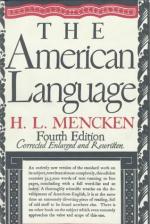
|
| Name: _________________________ | Period: ___________________ |
This test consists of 15 multiple choice questions and 5 short answer questions.
Multiple Choice Questions
1. What is the English meaning of the Hawaiian word "lanai"?
(a) Bathroom.
(b) Garage.
(c) Balcony.
(d) Porch.
2. What English word does the author of "Men and Manners" lament about the American re-signification?
(a) Clever.
(b) College.
(c) Buttock.
(d) Missionary.
3. What letter, when preceding a consonant, greatly irritated Henry James like a "morose grinding of the back teeth?"
(a) G.
(b) E.
(c) R.
(d) T.
4. Which European language has exerted the most influence on the American language?
(a) German.
(b) French.
(c) Italian.
(d) Spanish.
5. According to Mencken, what did the first generations born in the New World value as a virtue over enterprise and resourcefulness?
(a) Ingenuity.
(b) Courage.
(c) Temperance.
(d) Niceness.
6. According to Mencken, how do the English pronounce "been?"
(a) Bein.
(b) Bean.
(c) Bain.
(d) Bin.
7. According to the report of Beverley, what did a group of soldiers turn into after eating some Jimson Weed?
(a) Fools.
(b) Somnambulists.
(c) Zombies.
(d) Corpses.
8. Which of the early presidents does Mencken identify as archetypal of the new American?
(a) James Monroe.
(b) Andrew Jackson.
(c) George Washington.
(d) Thomas Jefferson.
9. What country's works dominated the reading habits of the American colonists in the latter 18th century?
(a) Denmark.
(b) Germany.
(c) England.
(d) France.
10. According to Mencken, how do the Americans consider the precise English use of the indefinite pronoun ("one")?
(a) Ambiguously.
(b) Respectfully.
(c) Apathetically.
(d) Disdainfully.
11. From what language does the English word "moose" come?
(a) English.
(b) Italian.
(c) Cherokee.
(d) Algonquin.
12. What American writer does Mencken claim likely inspired envy in British writers?
(a) Griswold.
(b) Poe.
(c) Fowler.
(d) Irving.
13. Who is the author of "Dissertations on the English Language"?
(a) Thomas Jefferson.
(b) Noah Webster.
(c) Benjamin Franklin.
(d) H.L. Mencken.
14. Whose clarity of prevision does Mencken praise in the opening of Chapter 1.1?
(a) Franklin.
(b) Jefferson.
(c) Madison.
(d) Waldo.
15. Who proposed a generally accepted nomenclature for currency in 1785?
(a) Richard Grant White.
(b) Thomas Jefferson.
(c) Noah Webster.
(d) Gouverneur Morris.
Short Answer Questions
1. Mencken claims that Noah Webster contains less of the scientific inquirer and more of what?
2. Which of the following groups of foreign immigrants does Mencken not attribute influence over American English in Chapter 6.4?
3. To what continent does Mencken attribute the acknowledgment of the differences between American and British English?
4. Which Founding Father is said to have sought to establish a new American alphabet?
5. According to Mencken, the name of what game puzzles etymologists?
|
This section contains 386 words (approx. 2 pages at 300 words per page) |

|




